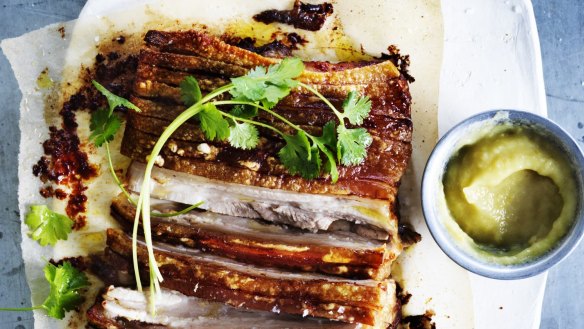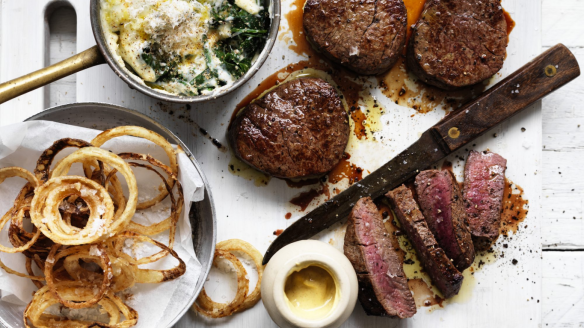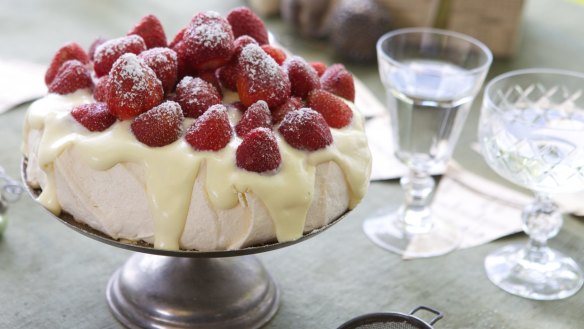Adam Liaw's tips for cracking those dishes you just can't get right – part 2

Continuing on from last week's column, I'm taking on the common dishes that people struggle to cook well. You all suggested these dishes to me on Twitter, so I hope you find them useful. From perfect steaks to pavlova, let's get into it.
Pork crackling
The best pork crackling is made when dry pork skin is first softened, then heated quickly to vapourise the small amount of water remaining in the skin, which expands and bursts out to form the "bursting bubble" structure of good crackling.
To achieve this, salt the skin heavily and leave the pork uncovered in the fridge overnight. Brush off most of the salt and cook your pork at its ordinary cooking temperature until done, before turning on a high grill at the end to create the crackling. If some parts of the skin that are closer to the heat start to blacken, just cover them with a little foil.
Some recipes suggest blasting the pork with high heat at the start of cooking instead, and while that sometimes works, it can also result in leathery crackling because the skin has not yet softened enough, so I think it's better leave the crackling process to the end.
Scrambled eggs
The issue with sub-optimal scrambled eggs is almost always overcooking. Start by getting everything else ready first. Bacon, toast, tomatoes, whatever – the eggs should be the last thing you cook.
Put a generous amount of butter or oil into a pan (non-stick preferably) over medium heat and then add your beaten eggs. As they set, run a spatula or wooden spoon through the eggs a few times to crumple them, allowing the uncooked egg to fill the void in the pan made by the path of the spoon, then – and this is the big point – while the eggs still look too wet to eat, take them off the heat, season and serve.
Eggs continue to cook after they're out of the pan, so if they look right in the pan they'll be overcooked by the time they get onto the toast.
Steak
OK, settle in. Everybody has an opinion on how to cook a steak, but there is a lot more myth than fact.
The often-suggested "rules" of flipping it once only, making sure it's at room temperature before cooking, or giving it 3 minutes per side might work for some steaks, but certainly won't work for all.
This is because most methods don't take into account that every steak is different, and should be treated accordingly. Fillet cooks very differently to a sirloin, and a thick sirloin cooks differently to a thin one. Wagyu cooks differently to Angus and cooking steak in a pan will be very different to cooking it on a barbecue.
The goal of steak cooking is simple: You should try to achieve a nice brown crust on the outside while keeping it as juicy as possible.
The crust is very important. To help this along, I season a steak very well with salt just before it goes into the pan. Use a heavy pan (or a barbecue) and don't overcrowd it. I cook one steak at a time per pan, but on a barbecue you can afford to cook more. Meat absorbs a lot of heat so if you put too many chunks of meat into one pan, the heat will drop and they won't brown.
Browning is important for both taste and texture. It gives the steak a meatier, more savoury taste. A tastier steak will stimulate more saliva production, so the process of chewing will have more liquid and the steak will feel juicier. A little gross to consider a part of the sensation of juiciness in eating a steak is your own saliva but hey, that's science.

So, how many times do you flip a steak? Barbecue cooks will die on the hill of once versus many, but the truth is it depends entirely on the steak.
Flipping a steak more frequently means that the top of the steak is hotter, so it will cook a little faster. Flipping it fewer times means it will take longer to cook.
Thinner steaks, or steaks I want to eat more rare (such as fillet), I'll flip fewer times so they have more time in contact with the pan, giving a better brown crust.
Thicker steaks or ones that I want to cook through to medium-rare (or beyond) I might flip a few more times so they cook more quickly. The number of times you flip a steak is more about getting the brown crust on the steak to the point you want it, when the steak is done.
How do you know when a steak is done? It should be obvious that given the number of different types of steak and thicknesses, prescribing a number of minutes per side will not work.
Generally a steak will become firmer the more it cooks to well-done, so press the steak and feel when it's ready. I tell people to press the steak and imagine you're cutting it with a knife. When it feels how you think it should feel when you cut into it to eat, take it out of the pan (or off the barbecue).
And finally, resting. Resting a steak is all important. It allows the flavourful meat juices inside the steak to thicken and redistribute themselves, so that it won't "leak" all over the plate the second you cut into the steak.
If you're worried about the steak going too cold, there's nothing wrong with flashing the rested steak back in the pan for a few seconds to "freshen" the sear before serving.
- Steak with 'home sauce'
- Fillet steak with creamed spinach and crispy onions (pictured)
- Adam Liaw's take on steak frites

Pavlova
If I had to diagnose the most common issue that results in collapsed, cracked, weeping or sunken pavlovas it would be failing to dissolve the sugar into the egg white. People get scared about "over-whipping" the eggs but that's hardly ever going to be an issue. The more the sugar dissolves, the more stable your meringue is going to be.
Add your sugar gradually and test if it's dissolved by rubbing the meringue between your fingers. If you can still feel grains of sugar, keep whipping.
Appears in these collections
The best recipes from Australia's leading chefs straight to your inbox.
Sign up- More:
- How to
